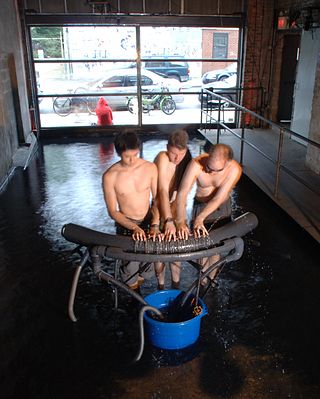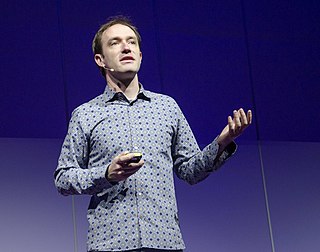
Nicholas Negroponte is a Greek American architect. He is the founder and chairman Emeritus of Massachusetts Institute of Technology's Media Lab, and also founded the One Laptop per Child Association (OLPC). Negroponte is the author of the 1995 bestseller Being Digital translated into more than forty languages.

The MIT Media Lab is a research laboratory at the Massachusetts Institute of Technology, growing out of MIT's Architecture Machine Group in the School of Architecture. Its research does not restrict to fixed academic disciplines, but draws from technology, media, science, art, and design. As of 2014, Media Lab's research groups include neurobiology, biologically inspired fabrication, socially engaging robots, emotive computing, bionics, and hyperinstruments.

Joichi "Joi" Ito is a Japanese entrepreneur and venture capitalist. He is a former director of the MIT Media Lab, former professor of the practice of media arts and sciences at MIT, and a former visiting professor of practice at the Harvard Law School. Ito has received recognition for his role as an entrepreneur focused on Internet and technology companies and has founded, among other companies, PSINet Japan, Digital Garage, and Infoseek Japan. Ito is a strategic advisor to Sony Corporation and general partner of Neoteny Labs. Ito wrote a monthly column in the Ideas section of Wired.

New Interfaces for Musical Expression, also known as NIME, is an international conference dedicated to scientific research on the development of new technologies and their role in musical expression and artistic performance.

Tod Machover, is a composer and an innovator in the application of technology in music. He is the son of Wilma Machover, a pianist and Carl Machover, a computer scientist.
The Hyperbow is an electronic violin bow interface that was developed as a result of an in-depth research project by students at MIT. The instrument is intended for use only by accomplished players and was designed to amplify their gestures, which lead to supplementary sound or musical control possibilities. It offers the violin player a range of expressive possibilities in its form as an augmented bow controller that lends itself to the control of bowed string physical models.

Golan Levin is an American new media artist, composer, performer and engineer interested in developing artifacts and events which explore supple new modes of reactive expression.
The UCD library, composed of five separate bodies, has varied ranges of digital and printed books on a wide range of topics. Namely architecture, arts and humanities, business studies, engineering, law, medicine, science, social sciences and veterinary medicine. In 2015 UCD Archives and the National Folklore Collection UCD came under the administrative umbrella of UCD Library. University College Dublin (UCD) is the Republic of Ireland's largest university. It is located in Dublin, capital of Ireland.

The Carnegie United Kingdom Trust is an independent, endowed charitable trust based in Scotland that operates throughout Great Britain and Ireland. Originally established with an endowment from Andrew Carnegie in his birthplace of Dunfermline, it is incorporated by a royal charter and shares purpose-built premises with the Carnegie Trust for the Universities of Scotland, the Carnegie Dunfermline Trust, and the Carnegie Hero Fund Trust.
NDRC is a national accelerator programme in Ireland, for "globally ambitious" entrepreneurs, delivered by a consortium led by Dublin-based Dogpatch Labs, and supported by multiple venture capital firms. It offers a "mentorship-driven" approach, with €100,000 "founder-friendly" funding, and early stage supports including non-equity pre-accelerator programmes available to entrepreneurs across Ireland. It also runs a Masterclass Series for companies working in the start-up space, teaching them how to support young digital venture teams with significant scale potential. It succeeded a previous version of the concept, run by a team on behalf of five Irish third-level institutions.
Sound and music computing (SMC) is a research field that studies the whole sound and music communication chain from a multidisciplinary point of view. By combining scientific, technological and artistic methodologies it aims at understanding, modeling and generating sound and music through computational approaches.
Media lab is a term used for several types of spaces and organizations that work in the fields of art, technology, and new media. It can refer to:

Groundhog Technologies is a privately held company founded in 2001 and is headquartered in Cambridge, Massachusetts, USA. As a spin-off of MIT Media Lab, it was a semi-finalist in MIT's $50,000 Entrepreneurship Competition in 2000 and was incorporated the following year. The company received the first round of financing from major Japanese corporations and their venture capital arms in November 2002: Marubeni, Yasuda Enterprise Development and Japan Asia Investment Co. It received second round of financing in 2004 and since then has become self-sustainable.

Silicon Docks is a nickname for the area in Dublin, Ireland around Grand Canal Dock, stretching to the IFSC, city centre east, and city centre south near the Grand Canal. The nickname makes reference to Silicon Valley, and was adopted because of the concentration of European headquarters of high-tech companies such as Google, Facebook, Twitter, LinkedIn, Indeed and startups in the area. The number of tech professionals working in technology firms in the area is about 7,000.
Georg Essl is an Austrian computer scientist and musician, who works in the areas of human-computer interaction, acoustics, mobile computing and mobile music. He is a visiting research professor at the College of Letters & Sciences at the University of Wisconsin–Milwaukee, and he is also affiliated with the Center for 21st Century Studies. Prior to that he was an assistant professor at the University of Michigan.
Lalya Gaye is a digital media artist and interaction designer whose early work was influential in the field of locative media. Currently based in Newcastle upon Tyne, UK, she is the founder and director of the international and interdisciplinary digital art practice Attaya Projects.
Realised between 2002 and 2004, the project Sonic City was pioneer projects in locative media, in particular the mobile music field which it contributed in establishing.

James Patten is an American interaction designer, inventor, and visual artist. Patten is a TED fellow and speaker whose studio-initiated research has led to the creation of new technology platforms, like Thumbles, tiny-computer controlled robots; interactive, kinetic lighting features; and immersive environments that engage the body.
Jane Ohlmeyer,, is a historian and academic, specialising in early modern Irish and British history. She is the Erasmus Smith's Professor of Modern History (1762) at Trinity College Dublin and Chair of the Irish Research Council, which funds frontier research across all disciplines.

Patricia Scanlon is an Irish entrepreneur. She founded SoapBox Labs in 2013, a company that applies artificial intelligence to develop voice and speech recognition applications that are specifically tuned to children's voices. It builds language learning appliances for education like text reading and speech therapy, and modules for toys, gaming, voice control, augmented reality, virtual reality, robotics, and the Internet of things. As of 2015, she is CEO of SoapBox Labs, headquartered in Dublin, Ireland. The startup raised $3.6 million.










